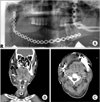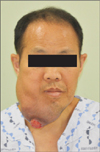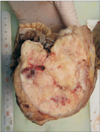1. Gorlin RJ, Pindborg JJ, Odont , Clausen FP, Vickers RA. The calcifying odontogenic cyst: a possible analogue of the cutaneous calcifying epithelioma of Malherbe. An analysis of fifteen cases. Oral Surg Oral Med Oral Pathol. 1962; 15:1235–1243.

2. Nazaretian SP, Schenberg ME, Simpson I, Slootweg PJ. Ghost cell odontogenic carcinoma. Int J Oral Maxillofac Surg. 2007; 36:455–458.

3. Tarakji B, Ashok N, Alzoghaibi I, Altamimi MA, Azzeghaiby SN, Baroudi K, et al. Malignant transformation of calcifying cystic odontogenic tumour: a review of literature. Contemp Oncol (Pozn). 2015; 19:184–186.
4. Martos-Fernández M, Alberola-Ferranti M, Hueto-Madrid JA, Bescós-Atín C. Ghost cell odontogenic carcinoma: a rare case report and review of literature. J Clin Exp Dent. 2014; 6:e602–e606.

5. Motosugi U, Ogawa I, Yoda T, Abe T, Sugasawa M, Murata S, et al. Ghost cell odontogenic carcinoma arising in calcifying odontogenic cyst. Ann Diagn Pathol. 2009; 13:394–397.

6. Lee SK, Kim YS. Current concepts and occurrence of epithelial odontogenic tumors: II. calcifying epithelial odontogenic tumor versus ghost cell odontogenic tumors derived from calcifying odontogenic cyst. Korean J Pathol. 2014; 48:175–187.

7. Cheng Y, Long X, Li X, Bian Z, Chen X, Yang X. Clinical and radiological features of odontogenic ghost cell carcinoma: review of the literature and report of four new cases. Dentomaxillofac Radiol. 2004; 33:152–157.

8. Arashiyama T, Kodama Y, Kobayashi T, Hoshina H, Takagi R, Hayashi T, et al. Ghost cell odontogenic carcinoma arising in the background of a benign calcifying cystic odontogenic tumor of the mandible. Oral Surg Oral Med Oral Pathol Oral Radiol. 2012; 114:e35–e40.

9. Bianchi B, Copelli C, Ferrari S, Ferri A, Sesenna E. Free flaps: outcomes and complications in head and neck reconstructions. J Craniomaxillofac Surg. 2009; 37:438–442.

10. Pohlenz P, Klatt J, Schön G, Blessmann M, Li L, Schmelzle R. Microvascular free flaps in head and neck surgery: complications and outcome of 1000 flaps. Int J Oral Maxillofac Surg. 2012; 41:739–743.

11. Zhang C, Sun J, Zhu H, Xu L, Ji T, He Y, et al. Microsurgical free flap reconstructions of the head and neck region: Shanghai experience of 34 years and 4640 flaps. Int J Oral Maxillofac Surg. 2015; 44:675–684.

12. Ozkan O, Ozkan O, Coskunfirat OK, Hadimioğlu N. Reconstruction of large palatal defects using the free anterolateral thigh flap. Ann Plast Surg. 2011; 66:618–622.

13. Leclère FM, Bosc R, Temam S, Leymarie N, Mirghani H, Sarfati B, et al. Reconstruction of large mandibulofacial defects with the composed double skin paddle fibula free flap: a review of 32 procedures. Laryngoscope. 2014; 124:1336–1343.

14. Myers LL, Ahn C. Does increased free flap size in the head and neck region impact clinical outcome? J Oral Maxillofac Surg. 2014; 72:1832–1840.

15. Cooley BC, Hanel DP, Anderson RB, Foster MD, Gould JS. The influence of diabetes on free flap transfer: I. Flap survival and microvascular healing. Ann Plast Surg. 1992; 29:58–64.
16. Cooley BC, Hanel DP, Lan M, Li X, Gould JS. The influence of diabetes on free flap transfer: II. The effect of ischemia on flap survival. Ann Plast Surg. 1992; 29:65–69.
17. Liu Z, Tian Z, Zhang C, Sun J, Zhang Z, He Y. Microvascular reconstruction in elderly oral cancer patients: does diabetes status have a predictive role in free flap complications? J Oral Maxillofac Surg. 2015; 73:357–369.

18. Rosado P, Cheng HT, Wu CM, Wei FC. Influence of diabetes mellitus on postoperative complications and failure in head and neck free flap reconstruction: a systematic review and meta-analysis. Head Neck. 2015; 37:615–618.

19. Genden EM, Rinaldo A, Suárez C, Wei WI, Bradley PJ, Ferlito A. Complications of free flap transfers for head and neck reconstruction following cancer resection. Oral Oncol. 2004; 40:979–984.

20. Bozikov K, Arnez ZM. Factors predicting free flap complications in head and neck reconstruction. J Plast Reconstr Aesthet Surg. 2006; 59:737–742.








 PDF
PDF ePub
ePub Citation
Citation Print
Print










 XML Download
XML Download